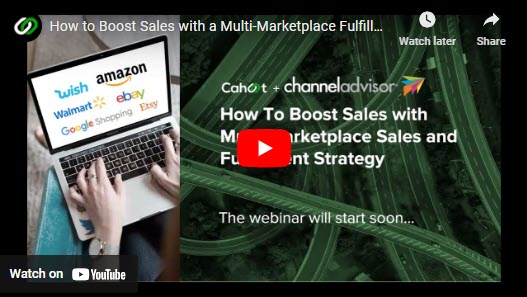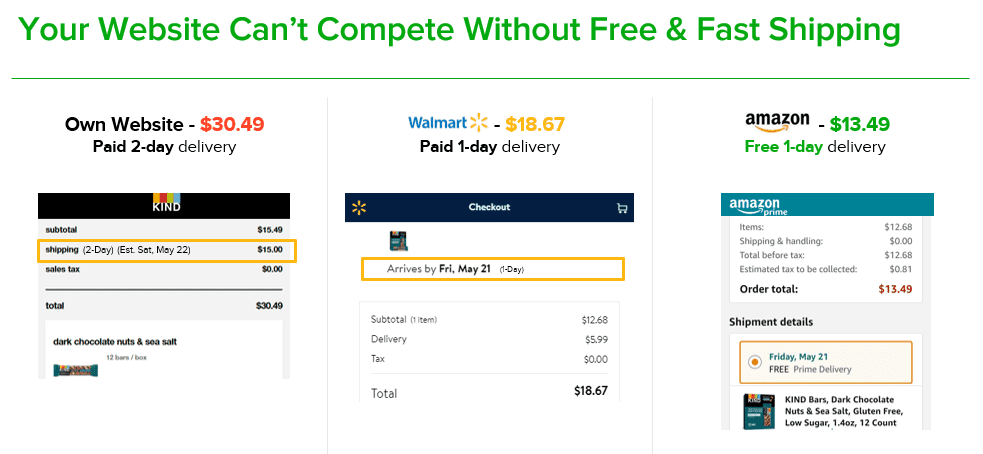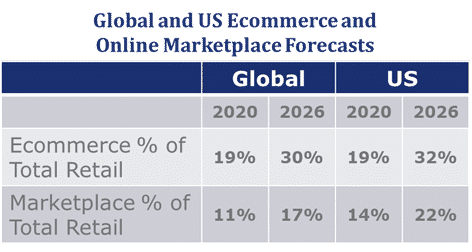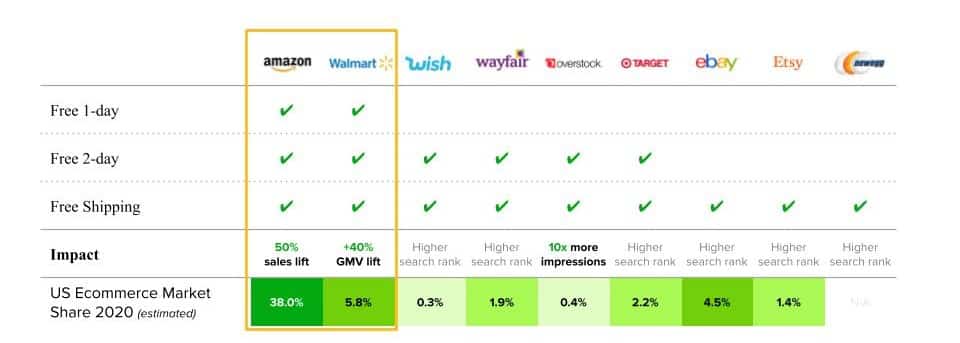How To Build an Effective MultiChannel Fulfillment and Sales Strategy
Align Fulfillment and Sales to Capitalize on The eCommerce Boom

The days of growing a solid D2C eCommerce business through a single brand website or a single marketplace are long gone. A recent Statista study found only 21% of consumers start their product searches on brand websites. But an overwhelming 63% of them go to Amazon, and 25% go to other online marketplaces first when they start searching for a product to buy.
The only way retailers can create sustainable growth in this new landscape is to list products on all the relevant marketplaces their target consumers shop and to give the people what they want most – fast and free shipping. A recent Shopify study found that selling through three or more channels can result in a sales increase of 200% or more. The ability of merchants to offer fast and free shipping remains the most significant influencer of where consumers shop. In fact, 72% of consumers say that free shipping is what they want to see at checkout. Conversely, unexpected shipping costs drive almost 70% of cart abandonment. Thanks to Amazon, free 1-day shipping is quickly replacing the old norm of free 2-day shipping. Therefore, it’s crucial to align your eCommerce order fulfillment strategy with your sales strategy.
In this article, I’ll explain everything you need to know about building a successful multichannel ecommerce strategy and how to create a fulfillment strategy that supports growth across all your existing and future sales channels.
Sorry Big Brands – Your Website Can’t Compete with Marketplaces

KIND bars are delicious, nutritious and customers love them! But customers won’t buy bars directly from the KIND website when they can find them for half the price and get them delivered twice as fast on marketplaces like Amazon and Walmart.
Consumers are unlikely to go directly to a brand website when looking for a product they want to buy. Instead, they prefer to go to online marketplaces to search for all kinds of products and easily find lots of options to choose from.
Marketplaces have gained influence over consumer purchasing by providing what is most in demand: price, convenience, and selection. Now thanks to Amazon, one of the most powerful drivers of their popularity is the availability of free 1-day shipping.
Amazon launched Prime in 2005 with free 2-day shipping for members. More recently, Prime has moved to free 1- and 2-day shipping for eligible purchases. Third-party sellers in the Seller Fulfilled Prime (SFP) program are now also required to guarantee free 1- and 2-day delivery or risk losing their Prime badges. Amazon’s power, popularity, and cachet among consumers have now set the standard that all shipping should be fast and free. This shift in expectations has led competitors like Walmart, eBay, and others to enact their own free 1- or 2-day shipping programs to stay competitive.
Another reason consumers trust and prefer to shop online marketplaces is the availability of customer reviews. Shoppers value the opinions of friends and family. When they can’t get that, customer reviews are the next best thing. Unfiltered remarks from other consumers influence purchase decisions and help build confidence in a product’s value.
Finally, buying from a marketplace is usually easy. Between accessibility through apps and mobile sites to easy comparisons and returns, marketplaces are often a more attractive choice than a brand site. Consumers want to be able to look at multiple products at a time. If they have to return a purchase, they want it to be as hassle-free as possible. Marketplaces are increasingly catering to these consumer needs, and the result is greater conversions for retailers.
Selling on One Marketplace is No Longer Enough

E-commerce is exploding. In fact, US eCommerce grew 44% in 2020 alone. A multichannel sales strategy can help you keep up with the competition and grow your business.
The increasing prevalence of marketplaces presents both challenges and opportunities for online retailers. Consumer demand for easy online shopping is growing, as is their selectivity of where they want to make purchases. Easier sourcing of products and the ability to sell using technology have also led more retailers and direct-to-consumer brands to enter the market.
Though these conditions create a more competitive space for retailers, they also provide access to more sales potential than ever. The more screens your product is accessible from and the more targeted your listings, the greater the chance and impressions of conversions.
“Cahoot has amazing technology in addition to their large warehouse network, sort of like FBA but without the hefty fees or restrictions. Cahoot saved our peak-selling season!”
– Joel Frankel, Fames Chocolates
Why You Need a Multichannel Strategy Now
The explosive growth of new online marketplaces is accelerating quickly, so now is the time to adopt a multichannel strategy. It may have taken 15 years for the number of global marketplaces to more than double. But, remember, that number has quadrupled since 2010 and will continue to grow as more strategies for targeting consumers prove successful.
If you want to capture the attention of prospective customers as they go from site to site and increase your chances of earning a sale, you must list your products on multiple marketplaces or risk a loss of market share. A recent Shopify study found that adding just one additional sales channel generates an average of 38% more in revenue. When you add two channels, that increase is nearly triple at 120%. And the sales keep climbing the more places consumers can find your products. This is why multichannel strategies are a must today.

E-commerce is exploding. In fact, US eCommerce grew 44% in 2020 alone. A multichannel sales strategy can help you keep up with the competition and grow your business.
How to Build a Successful Multichannel Strategy
The secret to a strong, successful multichannel sales strategy is in how you approach operations, expansion, and optimization. Listing products and managing inventory and fulfillment all become more complex when selling from more than one site. Therefore, keeping up-to-date with the requirements for each channel is crucial. Some strategies include:
- Ensure product information is current for every listing on every platform.
- Invest in inventory control technologies that enable you to track across marketplaces can help you make better-informed purchase choices.
- Understand your responsibilities for meeting all SLAs. For example, to participate with the Amazon Seller Fulfilled Prime (SFP) program, you must maintain1-day and 2-day delivery-speed metrics or risk getting suspended.
If you’re considering a multichannel sales strategy, also think about how to scale your business. Start by evaluating the marketplaces you want to enter and determine what resources, skills, and contacts you’ll need to move into those spaces. Then look at what you’ll need to keep up with inventory and your eCommerce order fulfillment needs. Consider that you may need to make additional inventory investments to accommodate the kind of expansion you’re targeting.
Lastly, it’s never been more important to know how to win the Buy Box or be at the top of search listings. Winning the buy box can give your listings up to 10-times more impressions. Understand how products are searched for, found, and priced on every marketplace site you want to list so you can optimize your listings. Major factors include:
- Consumers want fast and free delivery. Frequently marketplaces are giving the Buy Box and search rank preference to sellers that do this.
- Meeting channel requirements while also giving consumers accurate and robust information that helps them make a purchase decision.
- Constantly reviewing inventory and changing SKUs to keep up with consumer buying habits.
- Having the pricing and fulfillment resources to support a multichannel strategy.
Choose The Right Marketplaces for Your Products
Implementing a multichannel strategy is not about selling everything you have on every site. Broad marketplaces like Amazon, eBay, and Walmart will likely continue to attract consumers interested in a wide variety of products. However, you should also consider marketplaces that focus on relevant product verticals or market segments.
For example, fashion-focused shoppers can go to 11 Main, Curated by Anthropologie, and Tradesy. Those looking for consumer electronics can go to Newegg or Best Buy’s marketplaces. Home and garden shoppers have several choices, such as Home Depot, Overstock, Wayfair, and more.
Another type of marketplace that is growing in popularity targets different consumer segments. For example, sites specializing in products for women, men, children, young and trendy shoppers, deal hunters, etc., are tapping into another layer of the consumer journey.

Marketplaces that target a specific consumer segment or product verticals are seeing fast growth. Boost conversions by listing your products on the sites that best target the consumers you most want to reach.
Selling on a specialty marketplace can get your products to the consumers who want them faster and easier than a more general site – often with less competition. The key to winning with these sites is understanding who is shopping there, what they want, and how you can provide that.
Start your research by evaluating your top-selling SKUs, and ask yourself questions like this;
- Who are my top competitors in each marketplace?
- How do my prices compare?
- Which niche marketplaces may be a fit for my products?
Can your offers go head-to-head with theirs to win the Buy Box? As you answer these questions, focus on what kind of profit you could turn for each product and what kind of sales opportunities different marketplaces offer.
Not all of your products will likely be a good fit for all channels. You may find you can reach new markets with some SKUs in specific channels. But you’ll also find ones that underperform. Use this data and experience to customize your strategy. List the SKUs with competitive prices and acceptable margins—experiment with marketplace tools, like advertising, category matching, reviews, promotions, etc. And constantly monitor sales performance across all channels and make changes to your strategy based on the data.
Free Shipping Wins the Buy Box
Boosting marketplace conversions is all about winning the Buy Box. Adding free 1- and 2-day shipping to a listing is one of the most influential things you can do to qualify your product for Buy Box placement. Products in the Buy Box get 10-times more impressions. When they also come with free delivery, conversions can jump by up to 50%.
To prepare themselves for when other marketplaces follow Amazon’s lead, sellers must adopt free nationwide 1-day and 2-day delivery as their fulfillment standard. Not only do consumers now expect it, but they are also more likely to buy. Offering fast and free shipping helps you rank higher in searches, win Buy Boxes, and increase conversions.

Offering fast and free shipping is often a less expensive and more effective way to increase the visibility and conversions of your listings than purchasing lots of advertising. For example, free 1-day and 2-day shipping results in a 50% sales lift on Amazon and a 40% GMV lift on Walmart. In addition, Wish, Wayfair, Overstock, and Target offer higher search rank and up to ten times more impressions for free 2-day shipping. And eBay, Etsy, and Newegg all offer higher search rank for free shipping.
Here’s one final consideration. If you’re not offering free shipping, ranking in searches, or winning the buy box, you’re likely investing a lot of money in advertising to drive traffic to your listings. The problem is nearly 70% of online carts are abandoned by consumers because of added shipping costs. Using ads to funnel customers to your products is great. But if you lose the sales because they don’t want to pay for shipping, you’re just wasting money.
Multichannel Sales Need a Multichannel Fulfillment Strategy
Selling through multiple marketplaces can result in scores of new sales. However, it also poses some challenges in fulfilling those orders. It’s a balancing act of providing positive customer experiences and meeting expectations while managing inventory and shipping costs to maximize profitability.
A distributed fulfillment strategy that places your products closer to customers can help you find that balance. Expedited shipping often costs several times more than ground, which makes distributed fulfillment the most-economic option. By strategically placing your inventory in fulfillment centers throughout the country, you can meet 1- and 2-day shipping requirements at ground delivery rates.

Distributed fulfillment makes nationwide fast shipping profitable. A distributed plan for multichannel fulfillment requires keeping inventory in at least 4 locations to guarantee 2-day delivery nationwide. If your goal is to deliver most orders within one day, you’ll need nine or more fulfillment centers.
Multichannel fulfillment using a distributed model may sound costly and complicated. However, several options could make sense for your business and bottom line.
Use Marketplace Fulfillment
Some marketplaces offer eCommerce order fulfillment to make logistics easier for third-party sellers. For example, Fulfillment by Amazon (FBA) is available to sellers and handles everything from keeping inventory to packaging and labeling, customer service, and even returns.
Marketplace services are not a great option for multichannel fulfillment, however. First, fees for preparing and shipping orders that weren’t placed through that marketplace are often much higher. Second, many of these programs also don’t allow for shipping orders from other marketplaces. For instance, Walmart won’t allow you to fulfill orders using FBA. The good news is that there are Amazon FBA alternatives .
Every marketplace fulfillment program also has rules and fees that change often. Amazon’s new SFP program requirements and FBA’s new inventory limits are just two recent examples of changes that have negatively impacted sellers. You also may encounter higher fees during peak seasons and other add-ons that drive up your shipping costs. And if you want to use marketplace services for multichannel fulfillment, you’ll need to stock separate inventory with every marketplace you have listings to make it work.
Outsource to Multiple 3PLs
Many retailers outsource eCommerce fulfillment to third-party logistics (3PL) companies. These are primarily small businesses that specialize in getting products to the people who want them. Since they’re not affiliated with any marketplace, this is an option worth exploring for multichannel fulfillment.
One of the main drawbacks is that you would have to contract and operate with several 3PLs to get nationwide 1- and 2-day delivery coverage. These companies are relatively small and can deliver to only a limited area.
Relying on multiple companies to ship your products within a specific delivery window is also risky. Amazon SFP, in particular, strictly enforces its delivery policies and will suspend Prime badges if a seller doesn’t meet program requirements. 3PLs have varying levels of service that can put your product visibility and fast shipping badge at risk if they can’t ship orders in time. If you participate in Amazon Fulfillment By Merchant (FBM) or Amazon Seller Fulfillment Prime (SFP), you can use a fulfillment partner that specializes in Amazon SFP fulfillment services .
Finally, routing orders across multiple 3PLs is complex and labor-intensive. Traditional shipping software like ShipStation won’t cut it. Instead, you will need to invest in sophisticated and expensive eCommerce fulfillment software to manage inventory and shipments across all your 3PLs. When you’re selling on multiple sites and using several businesses to fulfill orders, closely tracking orders, inventory, shipping times, and other data are crucial to keeping costs down.
Join a Fulfillment Network
A peer-to-peer (P2P) network covers all your bases for multichannel fulfillment. This is a new option for retailers who need reliable, nationwide same-day fulfillment and 1- and 2-day delivery at affordable rates.
A great 3PL alternative , a P2P network is a collective of highly vetted eCommerce retailers from all over the country. They leverage excess warehouse space and fulfillment capacity to offer eCommerce order fulfillment to other merchants. This enables them to offset their own fulfillment costs or earn a new, stable revenue stream.

A peer-to-peer fulfillment network is an affordable option for keeping your inventory close to customers for economical 1- and 2-day ground shipping.
With a P2P network, you can strategically place inventory where you need it most and keep your fast and free shipping costs down. Moreover, setting up logistics is quick. You could be shipping from such a network in as little as two weeks. And you can rest assured that your multichannel fulfillment meets the requirements of all marketplaces where you sell.
Now is The Time to Launch a Multichannel Strategy
Today’s winning online businesses bring their products to their customers through all the channels where they shop. And, they give shoppers what they want most – fast and free delivery. In short, a multichannel strategy can deliver sustainable growth, but only if you do your research and carefully align your fulfillment and sales strategies. To learn more, check out the on-demand webinar.
“Cahoot has amazing technology in addition to their large warehouse network, sort of like FBA but without the hefty fees or restrictions. Cahoot saved our peak-selling season!”
– Joel Frankel, Fames Chocolates
